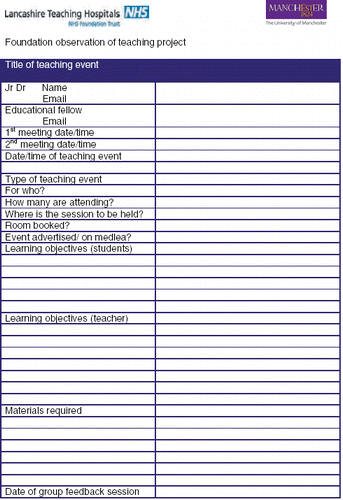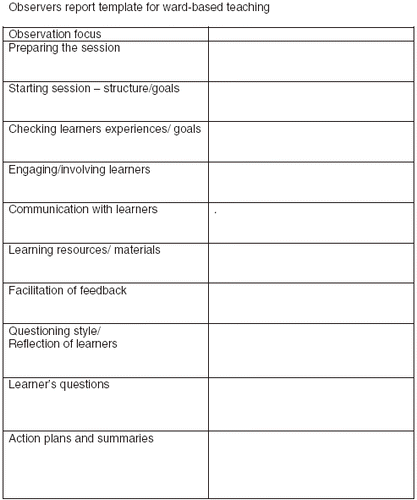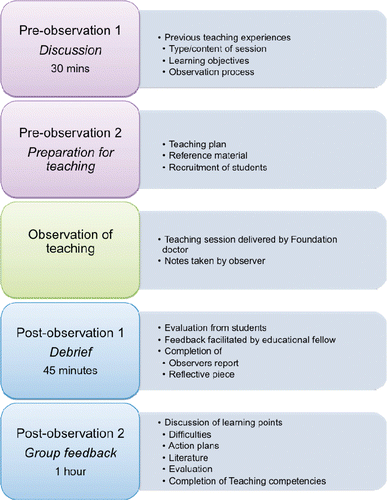Abstract
Introduction: Peer observation of teaching is important in the development of educators. The foundation curriculum specifies teaching competencies that must be attained. We created a developmental model of peer observation of teaching to help our foundation doctors achieve these competencies and develop as educators.
Methods: A process for peer observation was created based on key features of faculty development. The project consisted of a pre-observation meeting, the observation, a post-observation debrief, writing of reflective reports and group feedback sessions. The project was evaluated by completion of questionnaires and focus groups held with both foundation doctors and the students they taught to achieve triangulation.
Results: Twenty-one foundation doctors took part. All completed reflective reports on their teaching. Participants described the process as useful in their development as educators, citing specific examples of changes to their teaching practice. Medical students rated the sessions as better or much better quality as their usual teaching.
Discussion: The study highlights the benefits of the project to individual foundation doctors, undergraduate medical students and faculty. It acknowledges potential anxieties involved in having teaching observed.
Conclusion: A structured programme of observation of teaching can deliver specific teaching competencies required by foundation doctors and provides additional benefits.
Introduction
Peer observation of teaching has been recognised as being an important aspect of faculty development both in medical (Steinert et al. Citation2006) and wider educational circles (Martin & Double Citation1998). The importance of the ability to teach others is increasingly being recognised as important for doctors, especially with the reduction in time available for training with the European Working Time Directive, the impact of which is also being felt by undergraduate medical students (Black Citation2010). Indeed, many curricula from Tomorrows doctors (GMC Citation2009) through to higher specialist training contain within them specific teaching competencies.
The Foundation curriculum is one of these. The new doctor (GMC Citation2009) suggests that Foundation doctors must teach their peers and students under guidance, using appropriate skills and methods. Their training must provide opportunities to reflect on learning and practice and discuss issues with their educational supervisor and other colleagues. The foundation curriculum itself (UKFPO Citation2010) defines specific teaching competencies that must be attained. These include demonstrating an understanding of how adults learn, undertaking teaching, demonstrating appropriate preparation for teaching, setting educational objectives, identifying learning needs of self and group and demonstrating a learner-centred approach. There is a workplace-based assessment ‘developing the clinical teacher’ that should be completed by every foundation doctor. This implies that teaching should be observed and feedback given on performance.
Formal observation of teaching programmes is common in higher educational settings as a method of staff development and has been recommended by the Quality Assurance Agency (Gosling Citation2009). Peer Observation of Teaching is a method of evaluating teaching that can offer formative feedback to assist in the development of reflective processes of the teacher (Siddiqui et al. Citation2007). Gosling (Citation2002) describes three models of observation of teaching, an evaluative model, a developmental model and a peer review model. The developmental model involves experienced educators observing the teaching of more junior colleagues and providing them with feedback on their performance. This feedback is then used to help the teacher reflect on their performance and produce an action plan for improving their teaching. Therefore, this model lends itself well to develop the novice foundation doctor as teacher and assess the competencies required above.
The authors designed a developmental peer observation of teaching process for Foundation doctors within Lancashire Teaching Hospitals NHS Foundation trust. The trust is a large teaching hospital affiliated with the University of Manchester. There are 111 Foundation doctors split across two sites. The aims of the foundation observation of teaching programme were defined as:
development of a collaborative and reflective group of foundation doctors as educators;
achievement of required teaching competencies; and
provision of high-quality teaching for our medical students.
Methods
We developed our programme based on the key features of effective faculty development described by Steinert et al. (Citation2006). These include the role of experiential learning, the value of feedback, the importance of peers, adherence to principles of teaching and learning and the use of multiple instructional methods. The project was designed and refined over two academic years by medical education fellows in conjunction with our foundation faculty. The educational fellows had participated in peer observation of teaching previous to this and had completed assignments on peer observation process as part of a postgraduate certificate in medical education. They were supported by the Foundation training directors in the local trust. As a part of regular foundation training, two large group-teaching sessions on medical education were delivered to the foundation year doctors. These sessions lasted 2 h each and incorporated areas such as an introduction to adult education theory, facilitation of feedback and small and large group teaching. This was delivered to a cohort of 56 foundation year one doctors. We then offered the opportunity for any interested parties to design and facilitate a teaching session in conjunction with one of the medical education fellows. The educational fellow would observe the teaching session and facilitate a reflective dialogue afterwards. Formal ethical approval was not applied for but the University of Manchester and the local Foundation training programme director approved the project.
The observation process has three phases, a pre-observation meeting, an observation phase and a feedback meeting (Martin & Double Citation1998). An observation template was created to incorporate these and then piloted with the first cohort of foundation doctors (Appendix 1). The template contained free space areas for the foundation doctors teaching plan and reflective piece, the observers report and for an action plan. Following the pilot, a group feedback session was added to allow for wider dissemination of learning points (Cosh Citation1998; Gosling Citation2002).
Pre-observation stage
The pre-observation meeting is a very important part of the observation of teaching process. Siddiqui et al. (Citation2007) suggest that 45–60 min are required for this stage. The pre-observation meeting consisted of an exploration of the foundation doctors’ previous teaching experience, their knowledge of adult learning theories and a discussion of their objectives for the process. The type of teaching session to be observed was also discussed with the foundation doctor, based upon on their objectives and previous experience. The medical education fellow then provided the foundation doctor with some reference materials relevant to their session. For example, if the session was to be a bedside clinical teaching session, journal articles on bedside teaching and facilitating feedback were recommended. The observation process itself was also discussed, particularly the fear and anxiety that being observed may produce. This is recognised as being a barrier to development in peer observation (Peel Citation2005), especially when there may be perceived power differentials in the developmental model (Gosling Citation2002). The participants were reassured that this was for their development and that the reports of the teaching observation would be confidential.
Prior to the teaching event, the foundation doctor completed a teaching plan and sent it to the educational fellow. If either party desired, a further short meeting could then take place prior to the teaching event. Students volunteered to take part in the sessions when they were advertised on Manchester Medical schools online e-learning platform (Medlea). When the sessions were advertised, it was made clear that the teaching events would be delivered by a foundation doctor and observed by a medical education fellow.
Observation of teaching event
The foundation doctor and observer met immediately prior to the teaching event in order to reiterate the aims and timings of the session. When the students arrived, the observer introduced himself and made it clear that he would be observing the teacher as opposed to the students themselves and that he would be making notes during the session to be used for feedback. The observer also made it clear that they would only be observing and not participating in the session. The Foundation doctor would then deliver the session.
Post-observation stage
Immediately following the teaching event, the observer held a discussion with the medical students regarding the session, exploring what they particularly found effective and if they could suggest any changes for the teacher. The observer then discussed with the foundation doctor how they thought the event had gone and anything they had thought had gone particularly well or had found difficult. The observers were encouraged to take notes during the observation process so that specific feedback could be facilitated as this is said to be more powerful (McKimm Citation2009) and higher quality feedback is said to be essential in improving the skills of the observed teachers (Fullerton Citation1993).
Following this, the foundation doctor completed a reflective piece on their teaching session including action plans for further development. This was read by the observer but not assessed. The observer completed an observer report and recorded the results of the evaluation discussion with the medical students. Finally, in groups of three to four, the foundation doctors had a 1-h discussion about their learning points, difficulties they faced and solutions found. This session was facilitated by one of the medical education fellows. This session was also used to complete teaching competency assessments for the foundation doctors’ portfolios ().
Results
In total, 21 foundation doctors took part. Seven took part in the pilot session of whom three undertook bedside teaching sessions, three large group teaching sessions and one designed and faciliated a computer-enhanced mannikin simulation session.
In the next academic year, 14 Foundation doctors took part. Of these, 10 undertook bedside teaching sessions and 4 small group teaching sessions.
Student feedback
This was assessed by means of an electronic survey sent to students who participated in the bedside teaching sessions. They indicated that they did not find the presence of an observer intrusive (16/18 responses). When asked how these teaching sessions compared to other sessions of the same type, 17/18 responded ‘better’ or ‘much better’. When asked to rate the session overall, 4/18 responded ‘good’ and 14/18 ‘very good’. Free text responses indicated that students would like more sessions of this type. Some students complianed that they were unable to attend due to limited availability of places and this is something that we will look to address in future years.
Group feedback sessions
Three group feedback sessions were held following the pilot project to consolidate and disseminate the learning points. Two of these were for participants who had undertaken bedside teaching sessions and one for those who had undertaken small group teaching sessions.
Nearly all the participants described how they had been apprehensive and nervous about having their teaching observed in keeping with previously described teaching observation programmes (Peel Citation2005). Twenty-one of approximately 100 foundation doctors took the opportunity to have their teaching observed during the process and it has been recognised that the fear of criticism can be a reason for non-participation in teaching observation programmes (Adshead et al. Citation2006). However, a majority of participants in our project indicated that openly discussing these fears in the initial meeting meant they felt more comfortable during the observation process. A level of trust between the observer and observed teacher is said to be critical to the peer observation process (Gosling Citation2005) and this is said to increase with time (Farrell Citation2001). A number of participants seemed to indicate this by saying that a second meeting with the observer (normally immediately prior to the teaching session) helped to reduce their anxiety further. One participant commented that they actually felt more comfortable with the observer there as a ‘back-up’ if anything had gone wrong during the teaching session.
Participants discussed the themes given in and .
Table 1. Bedside teaching sessions
Table 2. Small group teaching sessions
Participants evaluation
All participants completed a reflective piece about their teaching session and developed an action plan for further learning. This was then uploaded to their foundation portfolios. The reflective pieces contained action plans for further teaching, and at the group feedback sessions, some participants related how their teaching practice had changed as a result. A follow-up questionnaire was sent to all participants at least 6 months after the observed teaching session asking them to describe any changes to their teaching practice. Examples of changes to teaching practice are illustrated by the quotes given in .
Table 3. Examples of changes to teaching practice
Discussion
The evaluations show that the aims of the project have been reached. All participants completed a reflective piece evaluating their own teaching following the session. They were also able to discuss their difficulties and learning points at the group feedback sessions, providing an environment for sharing learning.
Student feedback also indicated that they found the teaching useful and they were able to offer insights into what they found valuable about the teaching process.
It should also be recognised that the participants in the project volunteered to have their teaching observed which may bias the results. It may be that this detailed process of teacher development is not suitable for all foundation doctors, just those with a particular interest in the field of medical education. This argument is given credence by Shortland (Citation2004) who found that, when peer observation was introduced on a compulsory university wide basis, staff did not engage with it fully with a desire to change their teaching practice.
The observers commented that they too found the process useful, particularly in the discussions about teaching with the students. Fullerton (Citation1999) also describes this ‘rare opportunity to observe students reaction to teaching’ as being one of the benefits of observation of teaching to the observer. The educational fellows commented that they had reflected on their own teaching practice as a result of observing others teach, something that Beckman (Citation2004) also describes, commenting that ‘teachers act as a mirror to the peer reviewer’.
The authors recognise several limitations of our study. We did not have a control group to see if the changes to teaching practice may have occurred either after the preliminary session which all foundation doctors attended or simply through time and greater experience in the workplace. As we took volunteers, it may be that these individuals had a greater motivation to teach and the process may not be equally effective if applied to all foundation doctors. The evidences of changes to teaching practice are self-reported, not observed and are therefore open to bias.
Conclusion
We have outlined how a developmental observation of teaching project may be used to deliver teaching competencies set out in the foundation curriculum and develop foundation doctors as educators. This has resulted in technical and pedagogical changes to the participant teaching practice, and the process has also benefitted the observers and medical students. We intend to continue with this process in the future and it will be interesting to see how the participants develop into the educators of the future.
Declaration of interest: No declarations of interest are declared by any author.
References
- Adshead L, White PT, Stephenson A. Introducing peer observation of teaching to GP teachers: A questionnaire study. Med Teach 2006; 28(2)e68–e73
- Beckman T. Lessons learned from a peer review of bedside teaching. Acad Med 2004; 79: 343–346
- Black J. Strong foundations. Ann R Coll Surg Engl 2010; 92(Suppl)150–151
- Cosh J. Peer observation in higher education – a reflective approach. Innov Educ Train Int 1998; 35(2)171–176
- Farrell TSC. Tailoring reflection to individual needs: A TESOL case study. J Educ Teach: Int Res Pedagogy 2001; 27(1)23–38
- Fullerton H. Observation of teaching: Guidelines for observers. Observing teaching, S Brown, G Jones, S Rawnsley. SEDA Publications, Birmingham 1993; 77–83
- Fullerton H. Observation of teaching. A handbook for teaching and learning in higher education: Enhancing Academic Practice, H Fry, S Ketteridge, S Marshall. Kogan Page, London 1999; 200–213
- GMC 2009, The new doctor [Internet]. London: General Medical Office. [Published 2010 November 4]. Available from: http://www.gmc-uk.org/education/postgraduate/new_doctor.asp
- Gosling D. Models of peer observation of teaching [Internet]. The Higher Education Academy., York 2002, [Published 2010 August 24]. Available from: http://www.heacademy.ac.uk/resources/detail/resource_database/id200_Models_of_Peer_Observation_of_Teaching
- Gosling D. Peer observation of teaching. SEDA Paper No. 118. SEDA, London 2005
- Gosling D. A new approach to peer review of teaching. Gosling D, O’Connor KM, editors., In 2009, Beyond the peer observation of teaching. SEDA Paper No. 124, London: SEDA
- Martin G, Double JM. Developing higher education teaching skills through peer observation of teaching. Innov Educ Train Int 1998; 35(2)161–169
- McKimm J. Giving effective feedback. Br J Hosp Med 2009; 70(3)158–161
- Peel D. Peer observation as a transformatory tool?. Teach High Educ 2005; 10(4)489–504
- Shortland S. Peer observation: A tool for staff development or compliance?. J Furth High Educ 2004; 29(2)219–228
- Siddiqui ZS, Jonas Dwyer D, Carr SE. Twelve tips for peer observation of teaching. Med Teach 2007; 29: 297–300
- Steinert Y, Mann K, Centeno A, Dolmans D, Spencer J, Gelula M, Prideaux D. A systematic review of faculty development initiatives designed to improve teaching effectiveness in medical education: BEME Guide No. 8. Med Teach 2006; 28: 497–526
- UKFPO. 2010. Foundation Programme curriculum 2010 [Internet]. Cardiff: UK Foundation Programme Office. [Published 2010 November 4]. Available from: http://www.foundationprogramme.nhs.uk/pages/home/key-documents#curriculum
Appendix 1
Teaching observation template

Teaching session plan (including learning resources used by teacher – please list)
Evaluation
Self-evaluation/reflection
(Highlight any things that went well, and any difficulties. If you deviated from your teaching plan discuss why this may have happened)

Student evaluation – how was this done and by whom?
Group feedback session
Points for development – how are these going to be achieved?
